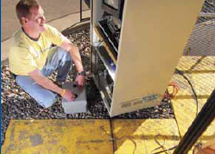A recycled swarm robot is being put to work in Tech Area 5, scraping sludge from an old tank too deeply buried and small for workers to safely reach.

Swarmy the robot could be an inexpensive answer to a cleanup problem that has evaded solution for several months.
In November 2005, a problem was discovered with an old wastewater tank in Tech Area 5. The tank, designed to collect process drain waste prior to sampling, analysis, and discharge, was found to have leaked some 4,000 gallons of water.
Originally built to support reactor operations for the Sandia Engineering Reactor in the early 1960s, the tank floor is 26 feet below ground level near Bldg. 6580. The tank’s process water is routinely tested before discharge to the city sewer system and has never shown any radioactive contamination.
But the tank bottom has a thin layer of old sludge on it that tested positive for extremely small but detectable amounts of radioactive forms of uranium, cobalt, and cesium; additionally, nonradioactive chemicals such as arsenic and cadmium were measured in extremely low concentrations. Though the contaminants found in the sludge were never found in the water, the sludge had to be removed before the tank could be closed and abandoned.
The 47-year-old tank’s shape, depth, and position have made clean-up efforts difficult. Its low-oxygen, confined-space environment has precluded manned entry and inspection.
The viscosity of the sludge also presented a technical challenge. Mock-up tests for moving, vacuuming, and pumping were conducted using various mixtures of flour and water to replicate the texture and viscosity of the sludge, but all of the standard approaches proved unsatisfactory.
Initially, the options for cleaning the space looked complicated and expensive. Experts from across the Labs were brought together to present their concerns: Environmental Restoration, Regulated Waste/Nuclear Material Disposition and its contractors, Industrial Hygiene, Radiation Protection, Environmental Programs and Assurance, and Facilities Projects representatives defined the solution boundaries. Because of safety concerns, the contractor organizations familiar with similar projects chose not bid on the job.
Dan Borneo (6336) was the facilities project manager involved with trying to get the tank cleaned up starting in April 2006.
“We didn’t want to send anybody down there,” Dan says. “Twenty feet below ground, you’re going through a 30-inch diameter hole with no place to stand up. I wouldn’t want to do that. The contractors didn’t want to do that, either. Nobody would touch it.”
Leaving the sludge alone wasn’t an option, but Dan didn’t want to just dig up the tank. “Digging it up would be extremely expensive, but we couldn’t just leave it alone,” Dan says.
Dan and his group looked at small robots attached to complex vacuums such as those being used at DOE’s Hanford site for similar projects. Each of those systems cost $300,000, plus another $300,000 to bring one here and set it up. Dan decided to ask around.
“The great thing about being at Sandia,” Dan says “is if you can dream up a solution to something, someone at Sandia has already built one and it’s sitting on their shelf somewhere. The key is finding the right person and the right shelf.”
In October, Dan wrote to a few robotics engineers and asked if they had any extra robots. John Feddema, manager of Intelligent Systems Controls Dept. 6743, wrote back and said that, as a matter of fact, he did have a few. Dan had found the right shelf.
“We had produced these swarm vehicles for an LDRD project on cooperative robots and for several DARPA programs,” John explains.
For this application, one small 10-inch by 2-foot swarm robot was fitted with treads from old snow blower tires for extra traction. “We were limited to 24 to 28 inches from diagonal to diagonal. It just barely fit within the riser hole,” says John.
The robot’s small size would allow it to get from one side of the 16-foot-long tank to the other.
In the most recent experiments, Swarmy was able to carry a tethered can to the farthest corners of the tank so that pulling the tether drags the can through the sludge, collecting the material and allowing it to be removed from the tank and emptied for proper disposal.
The process is still being refined. Don Hanson of Hot Cells and Gamma Facilities Dept. 1382 hopes to fit Swarmy with a small snow blower to further break up the sludge and push it toward the access hole.
After some trial and error, it looks like Swarmy may provide a long-sought solution, one that Dept. 1382 Manager Dave Wheeler is happy to have now.
“Getting the sludge out of the tank ensures that future releases don’t happen,” he says.